My first encounter with goose was Christmas 2006. My mother-in-law had decided to forego the traditional family feast of ham, turkey or roast beef and opt for goose instead. Ginny is a fine cook, but she had no experience with goose.
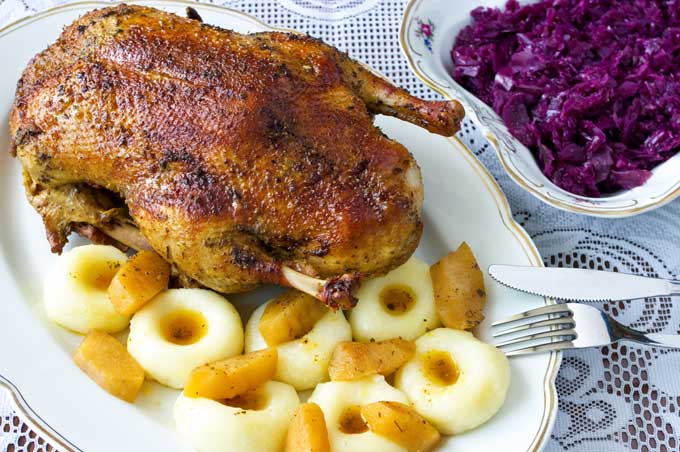
I was at my six month mark in my last pregnancy and when we arrived at my in-laws, the interior seemed like it was out of a Norman Rockwell painting, all red and green with the windows fogged up from various dishes already being prepared.
I was first one inside, eager to start messing around the kitchen and munching on goodies. I opened the door and the most god-awful smell slapped me right in the face.
Not being able to go in, and not being able to go in, I jumped off the steps and high crawled to the shrub line, where I upchucked breakfast.
And that wasn’t the end of it. The recipe she had followed said nothing of piercing the skin and fat so that it could render out when it cooked. There was no mention of removing the melted fat periodically over the course of cooking, so for the most part, the goose had been submerged in fat.
Sliced and slid on to plates, the melted fat (also called schmaltz ) continued to ooze out. What a nightmare.
At the time I didn’t know how to cook goose either, but I do now. Here’s how to prepare a delicious goose – without all the fat.
Why Goose?
Many of us in the United States remember our English heritage where roasted goose is a Christmas tradition. Who can forget Ebenezer Scrooge ordering the street waif to bring him the biggest goose in town?
Roasted goose is also an important part of Hanukkah. Once you’ve had latkes fried in goose fat, you’ll be ruined for anything less.
At this time, geese are not being raised in mass quantities. Some are free ranged and grown slowly over several months. So if you intend on serving goose, make sure you can actually get one.
You don’t see them in the frozen meats very often. Talk to your butcher. He can either order you one or know where you can get one.
In this day and age, where animal fat has become the enemy, goose can be a good choice. That’s because the fat on this particular bird is located in the skin and between the skin and the meat; the meat itself is quite lean.
Choosing the Best Size
A goose is not a turkey. You don’t want to purchase the biggest bird you can find. A big example often means it’s old and tough.
Look for a bird that weighs in at about 8-12 pounds. Figure approximately 1-1½ pounds of raw poultry per person. This large amount compensates for the amount of fat rendered during cooking and bones.
Wild goose is not as fat or as large as domesticated birds. ¾ – 1¼ pounds per person will result in a generous serving.
Two Mandatory Steps
First off, whichever way you decide to cook your goose, you need to make sure to remove the melted fat from the pan with a bulb baster. You do not want any part of the fowl to sit in the oven submerged in inches of fat
You also don’t want the melted fat to overflow the pan, then splashing and burning on the bottom of your oven. You would not BELIEVE the smell of burned goose fat.
Just don’t throw the fat away. I’ll explain why shortly.
Second, your goose must be cooked to an internal temperature of 165 degrees. An 8-12 pound bird will take 2½ – 3 hours to roast. Add another 15-30 minutes to the total time if you are stuffing it.
Check joint juices, they should be running clear. You should always use a meat thermometer to check internal temperatures.
Make sure your thermometer is not against any bone. The USDA says that if your bird was cooked to 165 degrees, the meat can still be a little pink, but it’s safe to eat.
If you’ve never cooked goose before, don’t freak out when you carve into the breast. While goose meat is considered poultry, their breast meat is quite dark due to the fact that so much oxygen needs to be stored in the breast because they do so much flying.
The Boil and Bake Method
Bring four or five quarts of water to a boil. While the water is heating up, remove the giblets from your bird and all the little pieces of visible fat, both inside and out. SAVE THE FAT, stick it in the refrigerator. Rinse the carcass well.
Place the bird, breast side up, on a roasting rack that you’ve set in the kitchen sink. You might have to put down a kitchen towel to protect your sink from scratching.
Using a ladle (or coffee cup) pour ¼ of the hot water over the breast. Rotate the bird one quarter turn (so one side is facing up). Pour another fourth of the water. Continue pouring boiling water onto the back and the other side.
Alternately, if you are fortunate to have a very large pot, you can blanch the carcass in boiling water. Place the bird in the pot and fill with enough water to cover. Remove the goose. This way you’re ensured to have enough water.
Bring the water to a boil and then add the fowl back into the pot. Cut the heat and cover for two or three minutes. Remove the bird from the pot.
Once the boiling water has come into contact with the body, you’ll notice that the skin has shrunk and lightened to almost white. Sprinkle salt and freshly ground pepper all over the bird, inside and out.
Tie the legs up with kitchen twine and tuck the wings under. Tuck the neck skin under the bird and secure with a skewer or toothpick. Place in a heavy-duty roasting pan and into the refrigerator for two days, to allow the skin to dry out.
When it’s time to cook the goose, preheat the oven to 400 degrees. Place the bird in a roasting pan ON a roasting rack.
If you want to speed up the process while evenly roasting all the sides to a golden perfection, try using a countertop convection appliance such as the Breville Smart Oven (see our review).
This also clears out your primary baking space so that you can concentrate on other dishes that you may be preparing for a huge family feast.
It’s common consensus that the rich, strong flavor of goose really doesn’t need to be fancied up with anything other than salt and pepper. However, other herbs and spices that work well are: thyme, paprika, parsley, marjoram, chervil and sage.

Pour about ½” of water in the bottom of the pan. This will keep the rendered fat from burning. Place the pan in the middle of the oven and roast for one hour, uncovered.
About every 30 minutes, baste the carcass and siphon off all the fat in the bottom of the pan. The grease will float on top of the water. You might have to add a little more water to the pan.
After one hour, lower the temperature to 325 degrees. Roast until the thigh meat is 165 degrees and juices from the joints are clear, approximately 2-2½ hours. During that time, continue to baste and remove the fat every 20-30 minutes.
Allow to stand at room temperature for 15 minutes before carving.
The Poke It and Roast It Method
Probably the easiest way to cook goose is to poke the skin and fat with a skewer or very sharp carving fork. Take care not to poke into the meat of the bird. You want the fat to drip out, not the meat juices.
Instead of poking straight in, try piercing with the tool held parallel. You need to make dozens and dozens of pokes, all over the body.
Preheat the oven to 400 degrees.
Rinse the carcass, removing the giblets and all the visible fat, both inside and out. Pat the bird dry. Some cooks remove the wing tip and use it later for the gravy or sauce. Salt and pepper the skin and the insides.
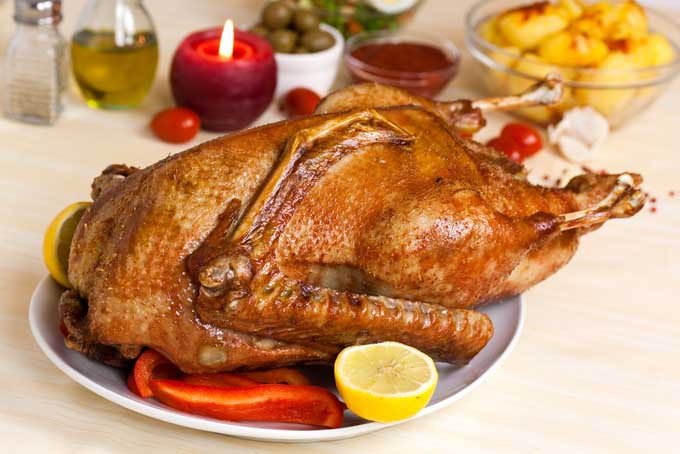
A good way to infuse some delicate flavor into the meat is to add an onion, a few carrots and/or a couple of stalks of celery to the cavity. You don’t even have to peel them.
Some folks like to place a couple of oranges in the cavity and then rub half a cut orange all over the skin.
Tie the legs together or force the bony ankles of the legs through a slit in the skin. Tuck the wings behind the back. Place the bird in the pan on a rack, breast up. Tuck the neck skin over the opening and secure with a skewer or a tooth pick. Add ½” of water to the pan.
Roast for one hour. Every 30 minutes baste the bird and then remove fat from the bottom of the pan. After the first hour, lower the heat to 325 degrees and continue roasting the goose for at least one hour or until the temperature taken deep in the meat (but not against the bone) is 165 degrees
The juices will run clear. Let sit for fifteen minutes before carving.
The Low and Slow Method
This method is very similar to the poke it and roast it method, except you are going to divide the cooking time necessary to cook the bird into quarters – one for each side.
Preheat oven to 250 degrees.
Rinse the goose and pat dry. Salt and pepper the bird inside and out. Place on the rack, breast side down. Pour about ½” of water in the pan. Roast for one hour. Baste every 20 minutes and siphon off any melted goose fat.
Remove from the oven. On one side, poke at least two dozen holes into the carcass, being careful to only pierce the skin and the fat. Place the fowl back in the rack with that pierced side down.
Go ahead and pierce the side that is now facing up. Roast another hour, continuing to baste and remove fat. Flip the bird to the other side for the third hour of roasting, basting and siphoning.

After the third hour, remove the goose again and this time flip the bird so the breast is up. Make about 25 pokes into the skin and fat. Increase the temp to 350 degrees and roast for one more hour, still basting and removing the schmaltz (fat).
At the end of four hours, the juices should be running clear and the internal temperature should be 165 degrees. Don’t forget to let it stand for 15 minutes so the juices can all redistribute before carving.
To Stuff or Not to Stuff
A goose can be stuffed like any other poultry. The key is whatever method you choose to use, you choose strong hardy flavors that can stand up to goose meat.
Because the body cavity of a goose is quite small, many cooks prefer to turn their stuffing into dressing and roast it alongside. Instead of stuffing, many folks insert aromatics like onions, celery and apples, oranges and/or lemons into the body.

If you do stuff, figure in an additional 20-30 minutes of cooking time.
Most turkey or chicken stuffing or dressing recipes can be adapted to goose. Stuffings that use fruits like raisins and prunes are wonderful when roasted. Instead of using plain white bread, consider using rye, hearty wheat or a really good loaf of French bread.
Do you like mushrooms in your stuffing? Instead of the bland buttons, why not try porcini or wild mushrooms if they’re available.
Also apples, onions and celery always work in stuffing. And the oily feel of hazelnuts, pecans or walnuts works well with the moistness of the goose meat.
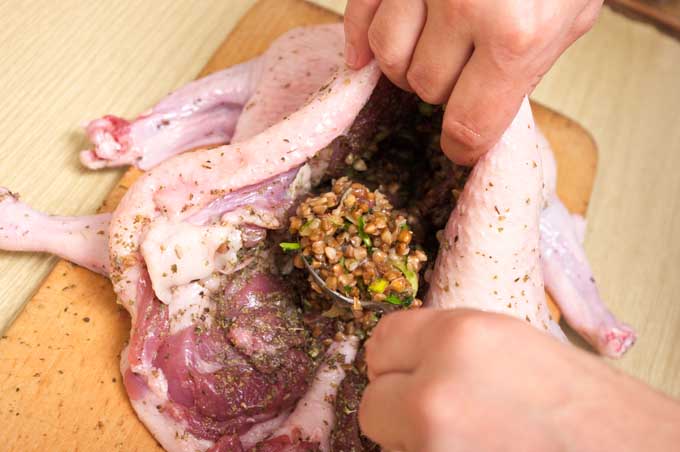
What to do With all That Schmaltz?
While the bird is cooking and you are “harvesting” capacious amounts of fat, you might be wondering what the heck you are going to do with those clumps of fat you removed from before you started roasting.
A goose renders two kinds of fat, both of them more valuable than gold to any chef. There is “brown” goose fat which is what you are periodically removing from the roasting pan.
The other kind of schmaltz is that obtained from melting down the fat that was removed before roasting. This is “blonde” schmaltz, and no less valuable than the dark.
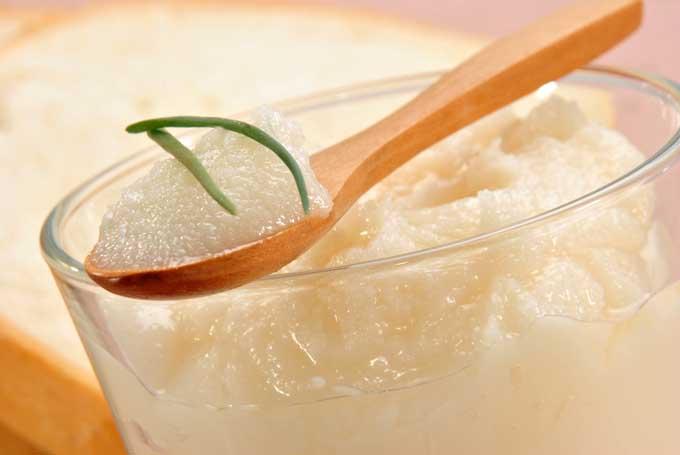
To render blonde schmaltz, place the fat in a heavy duty saucepan and add about the same amount of water as you have fat. Place the pot over low and as the fat melts, the water will eventually evaporate out
When the water is gone, the fat will begin to sizzle. Go slow, you don’t want to brown this fat, but keep it light.
Bonus: Roasted Potatoes with Goose Fat
There are thousands of recipes that require goose fat, but a universal favorite is “Roasted Potatoes with Goose Fat.” Take four large baking potatoes and peel. Cut into one inch slices. Place in a pot of cold water and bring to a boil. Parboil for approximately 7 minutes.
Turn off the heat and drain the potatoes. Return the spuds to the hot pot and place it back on the burner, allowing the residual heat to evaporate any excess water and dry out the potatoes for five minutes. Then cover the potatoes and let sit for another 12-15 minutes.
While the potatoes are drying, take a deep roasting pan and pour ¼ cup of melted fat into the pan and put in a 400 degree oven. While the fat is heating, mix 2 teaspoons of garlic salt, 1 teaspoon of pepper and 1 teaspoon of paprika together.
When the potatoes are dried, remove the roasting pan from the oven and careful add the potatoes. Sprinkle with seasonings and toss in pan until all the potatoes are coated.
Return to oven. Bake, turning the potatoes twice, for 55 minutes or until the spuds are tender. This treat can be enjoyed all on its own, but can also accompany chicken, roast beef or even goose.
Enjoy.
About Lynne Jaques
Lynne is a stay-at-home mother of two boys. As a former US military officer and the spouse of an active duty US military member, Lynne enjoys traveling the world (although not the moving part!) and finding new cuisine and methods of preparing food. She also has the habit of using parenthesis way too much!



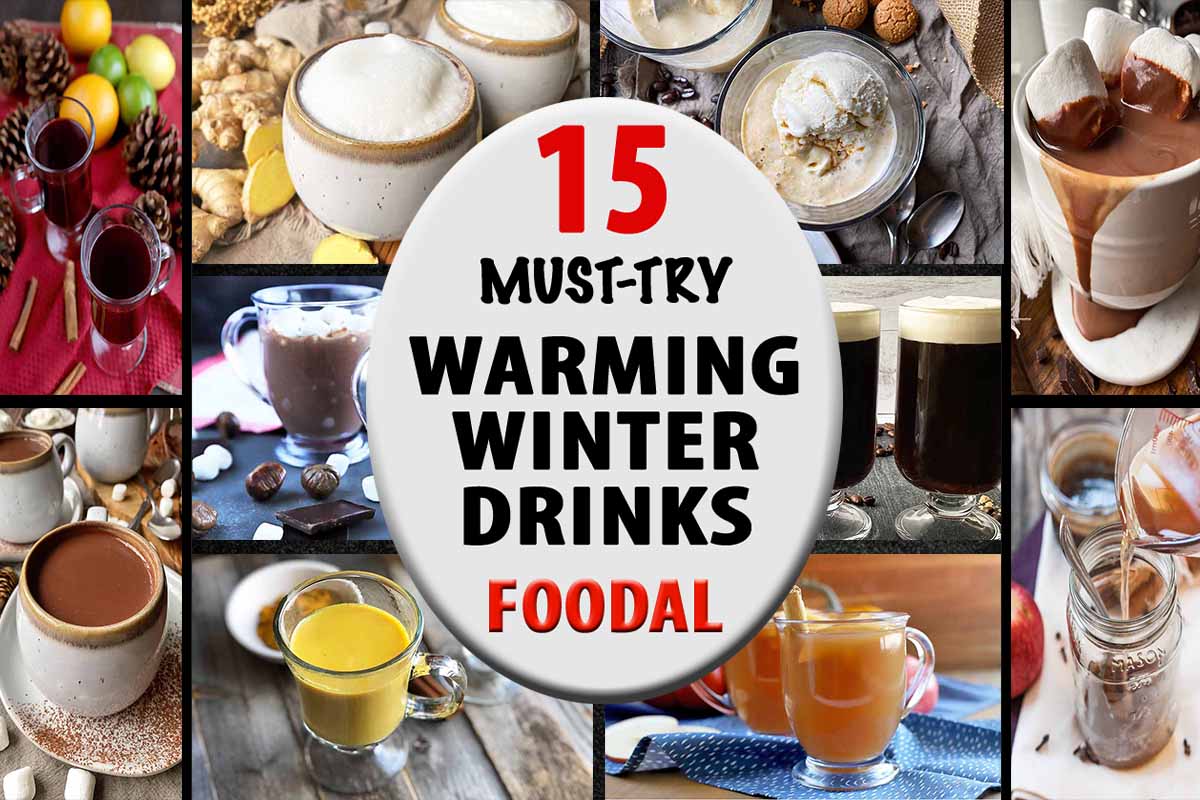
Those pictures are simply mouth-watering. Our country’s known for its love of chicken and fowl dishes but people eating goose are few and far between. Now I see what makes a great roasted fowl: stuffing. Thanks a lot for this recipe. Your posts are really informative, always giving me something to think about. I can refer my dad to this recipe so he can prepare roast goose for us over the holidays.
In all my life that my family and I have feasted on meat, we’ve never ever tried goose, even though I’ve heard of it personally. I sit here and I wonder how much the taste contrasts from chicken and turkey. The way it’s depicted in this article makes it seem just as delicious though, so you’ve done a great job conveying that. Who knows, maybe after seeing this, we’ll put a goose to roast out for Christmas.
I have never had goose. I’d love to try it. These photos make it look delicious! I am going to consider roasting one for Christmas or Thanksgiving this year.
Same here meterdlines, I have never had or prepared goose. I will be trying this out, but not over Xmas incase something goes horribly wrong hehe I like to do at least a trial run before feeding to friends and family – I know, I am a scardy cat.
You are not alone i see..in this battle of trying to keep the lips sealed lest a mistake occurs { i mean in the mouth-watering arena}…i need to re-read this over and over again till i get it right… never had goose before but the zeal churning within…., this year is not ending before i prepare goose and have it to my fill 🙂
I have always preferred duck over chicken when it comes to poultry, it is more flavorful and has a better texture, closer towards red meat. While I have not tried goose I have heard that it is closer to duck than chicken.
All these recipes certainly seem appetizing, I might even consider stuffing and roasting a goose for a Thanksgiving with a twist! 😛
These look absolutely delicious! I can’t wait until thanksgiving comes around so that I can try some of these recipes out. (:
This is definitely mouth watering and a must for the next celebrations. Goose fat is the best thing to roast potatoes in, they become finger licking good! A treat for the whole family as you mention indeed, when you cook a bird like that there is food for a family of 6, at what a great way to get together, may you all have great Thanksgiving celebrations full of love
🙂
These pictures are totally delicious I get hungry just looking at them. Though I cannot see myself getting my hand on goose any time soon. I might have to look out for that special white meat. I must admit I have never tasted goose before and I wonder how much it tastes like chicken. If possible I would replace the goose for chicken and try out some of the techniques I see mentioned here.
The last time I tried goose it came out dry, but this tempts me to give it another shot. I think we let all the good juicy fat drip out, so the flavors didn’t seep into the meat. We stuffed ours with lemongrass though. I think I just may try again with the tips you gave. I want to thank you. This has been an informative post.
I have never made goose but it’s definitely on my bucket list. I don’t know if I’ll attempt it during the holidays but this has planted the seed in my mind. The photos are pretty and make everything look so delicious!
Yum, yum, yum! Looks so good in the pictures. I’m tempted to try to make a goose now, but even with your wonderful guide, I’m worried that I’ll mess it up.
Well I guess there is no point being scared to try something new. I’ll let you know how it goes 😉
Well, I’ve never considered cooking goose before due to the excessive fat. It’s good to know that there are techniques to minimize it. Goose is often eaten in the UK at Christmas time and isn’t always easily available at other times of year.
I have made squirrel, gator, ostrich, snake, & kangaroo yet I’ve never tried my hand at a goose. I really don’t have a good reason why that is. Maybe because I never felt the need to go in search of it & I definitely don’t see it as an option when regularly grocery shopping. This is just the thing to add it to my list of conquered meals. Thanks.
Wow, never done this before, but will certainly never forget all the tips you have given here. This is a lot of extensive information if ever I do have the opportunity to cook this bird. I must say it does sound delicious although I never thought of eating them. You see I used to know a few of these when I was young, damn cheeky they were too! Make great guard dogs!
I would never willingly eat a goose. I find it difficult sometimes just to eat chicken, and turkey. I draw the line at geese and duck. My husband says these two birds are very tasty I wouldn’t know, and I plan to keep it that way.
@karmaskeeper
Leave hater-troll before I report you to the owner of this website!
As much as I love meat, in all my life I have never tried goose before. I had plenty of duck, but does that even compare to the taste of goose? I’ll have to give it a try sometime soon. I mean making french fries with duck fat is absolutely delicious, but if you say geese are better, then I’ll have to try it! 🙂
I can’t say that I have made this type of meat, at least not so far in my life. I think I may have eaten it in the past, but I have never prepared it on my own. I do like duck. I haven’t made that one either, but I have tried it. I wonder how comparable the two might be?
I think what has kept me from trying to make either of these is being scared of all the fat.
Thanks for the lessons!
It’s funny, I never tried goose though my father has an animal farm with gooses and the likes laying around. I’m sure it tastes amazing, I heard the meat is really soft as well.
I’m totally printing out all these tips. I’ve honestly never tried cooking a goose before. I think I’ve never tried it for lack of courage, since I wouldn’t of known what to do with a goose sitting on my kitchen counter. LOL. Thank you for the tips, you always give the best.
I really appreciate your tutorial on how to prepare a goose. I think that it’s one of the most special dishes!
Goose is not only tasty, but healthy. It’s lean and full of unsaturated fatty acids. Apparently goose meat reduces cholesterol, though I can’t vouch for this statement being a fact. I’m 100% sure that it contains many vitamins and minerals, like B6, selenium or pantothenic acid. I wish that me and my family could eat goose more often!
Fantastic article. I have been wanting to try goose but don’t believe it is available in my local area. I’ll have to make a trip up to Atlanta. I’m sure I’ll be able to find some there. Now that I know the proper techniques to cook it right and how to render the fat I will have to try it myself. Very informative, as always.
I’ve never eaten Goose or know of any families that make it during the holidays. It’s interesting to know that this was a common tradition years ago.
I’d definitely be open to trying this receipe as it looks delicious. I guess you’d buy this meat at a local butcher shop? I’ve never seen it in my grocery store.
I bet goose is a good alternative for those who are worried about how the animal was treated in it’s life… you know, whether or not it was allowed to be out and about, not piled on top of other animals and force fed hormones and antibiotics and such. Right? Because geese are not so common anymore, so they probably aren’t factory farmed like chickens. Thanks for posting, I am definitely going to try this the next holiday I host at my house (although I’m going to read the directions 100 times over before doing it)! I have to say, although I’m not Jewish, the goose fat latkes you mentioned early in the article also sound fantastic.
The story you used to open this article with made me loose my breakfast. It sounded so gross. I can just picture a slice of goose on a plate oozing fat, what a nightmare. I’ve never actually made goose before but this article has got me interested. I might swing by my local butcher and ask if he knows where I can get one. Is it oilier than duck? I’d probably use the boil and bake method.
Now this is a very timely article from this site – this year my mother has been trying to do different things. So we had venison and duck instead of turkey and ham for thanksgiving. And for Christmas we’re going to try Goose – and New Years might be pheasant. Goose isn’t something we’ve done before, but it seems to cook like duck and we’ve had a lot of experience with that. Anyway thank you for the ideas and tips! Goose fat potatoes sounds nearly as nice as duck fat potatoes.
I’ve always heard about goose, but I have never eaten or prepared it before in my life. Looking at it now, I think it is a bit too high maintenance for my taste especially with all of the fat that comes off of it. At least with a turkey, I know what I’m in for and can pretty much cook it with my eyes closed. That and it’s pretty expensive to get a decent sized goose while a turkey is larger and more affordable in my books.
I would never throw my mother-in-law under the bus like that; and I’m pretty sure it was a “prize turkey” that Ebenezer Scrooge had delivered to Ms. Cratchit. The proper way to prepare goose is by smoking.